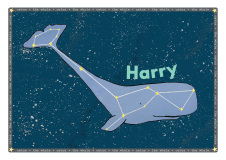

It is in the constellation Cetus.Īn alike depiction from Celestial Atlas (A. The discovery of the nature of the galaxy was accredited to Knut Lundmark and Philibert Jacques Melotte in 1926. The Wolf–Lundmark–Melotte (WLM) is a barred irregular galaxy discovered in 1909 by Max Wolf, located on the outer edges of the Local Group. Among some amateur astronomers, NGC 246 has garnered the nickname "Pac-Man Nebula" because of the arrangement of its central stars and the surrounding star field. NGC 246 (Caldwell 56), also called the Cetus Ring, is a planetary nebula with a magnitude of 8.0, 1600 light-years from Earth. IC 1613 ( Caldwell 51) is an irregular dwarf galaxy near the star 26 Ceti and is a member of the Local Group. As is spiral galaxy NGC 1042 and ultra-diffuse galaxy NGC 1052-DF2. The massive cD galaxy Holmberg 15A is also found in Cetus. Recently, the galactic cluster JKCS 041 was confirmed to be the most distant cluster of galaxies yet discovered. About 50 million light-years from Earth, M77 is also a Seyfert galaxy and thus a bright object in the radio spectrum.

It appears face-on and has a clearly visible nucleus of magnitude 10. Of these, the brightest is Messier 77 (NGC 1068), a 9th magnitude spiral galaxy near Delta Ceti. Deep-sky objects Ĭetus lies far from the galactic plane, so that many distant galaxies are visible, unobscured by dust from the Milky Way. One of the stars is a flare star, which are prone to sudden, random outbursts that last several minutes these increase the pair's apparent brightness significantly - as high as magnitude 7. 8.7 light-years from Earth, the system consists of two red dwarfs. UV Ceti is an unusual binary variable star. AA Ceti is an eclipsing variable star the tertiary star passes in front of the primary and causes the system's apparent magnitude to decrease by 0.5 magnitudes. The tertiary is not visible in telescopes. The primary and secondary are separated by 8.4 arcseconds at an angle of 304 degrees. It is a yellow-hued main-sequence star of magnitude 3.5.ĪA Ceti is a triple star system the brightest member has a magnitude of 6.2. Tau Ceti is noted for being a near Sun-like star at a distance of 11.9 light-years. The primary is a yellow-hued star of magnitude 3.5, 82 light-years from Earth, and the secondary is a blue-hued star of magnitude 6.6. γ Ceti, Kaffaljidhma ("head of the whale") is a very close double star. The traditional name "Deneb Kaitos" means "the whale's tail". It is an orange-hued giant star of magnitude 2.0, 96 light-years from Earth. β Ceti, also called Deneb Kaitos and Diphda is the brightest star in Cetus. It is a wide double star the secondary is 93 Ceti, a blue-white hued star of magnitude 5.6, 440 light-years away. Α Ceti, traditionally called Menkar ("the nose"), is a red-hued giant star of magnitude 2.5, 220 light-years from Earth. 420 light-years from Earth, it was discovered by David Fabricius in 1596. Mira pulsates with a minimum size of 400 solar diameters and a maximum size of 500 solar diameters. Its seeming appearance and disappearance gave it its name. Over a period of 332 days, it reaches a maximum apparent magnitude of 3 - visible to the naked eye - and dips to a minimum magnitude of 10, invisible to the unaided eye. Mira ("wonderful", named by Bayer: Omicron Ceti, a star of the neck of the asterism) was the first variable star to be discovered and the prototype of its class, Mira variables. Cetus is in the region of the sky that contains other water-related constellations: Aquarius, Pisces and Eridanus.

The Cetus was a sea monster in Greek mythology which both Perseus and Heracles needed to slay. Note: † Mira (ο Cet) is magnitude 2.0 at its brightest.Ĭetus ( / ˈ s iː t ə s/) is a constellation, sometimes called 'the whale' in English. Visible at latitudes between + 70° and − 90°.īest visible at 21:00 (9 p.m.) during the month of November.


 0 kommentar(er)
0 kommentar(er)
